Speed is a virtue in our fast-paced world, but some members of the animal kingdom have chosen a different path – the path of slowness. These animals move at an almost otherworldly pace, defying the rush and hurry of our daily lives. In this article, we’ll take you on a stroll through the world of the 15 slowest animals. From the languid crawl of the Garden Snail to the glacial glide of the Greenland Shark, we’ll explore the unique features, habits, and reasons behind their status as the slowest animals in the world.
- 01. Garden Snail – The True Snail Mail
- 03. Three-Toed Sloth – Life in the Slow Lane
- 03. Starfish – Slow and Steady
- 04. Star-Nosed Mole – A Delicate Touch
- 05. Dugong – Graceful Swimmer, Slow Mover
- 06. Sea Anemone – Life in the Slow Current
- 07. Banana Slug – The Cautious Crawler
- 08. American Woodcock – A Deliberate Dance
- 09. Gila Monster – Lethargic Lizard
- 10. Giant Galapagos Tortoise – The Majestic Plodder
- 11. Dwarf Seahorse – A Tiny Drifter
- 12. Manatees – Gentle Giants of the Water
- 13. Koala – Laid-Back Leaf Eater
- 14. Slow Loris – The Cautious Primate
- 15. Greenland Shark – The Ocean’s Mystery
01. Garden Snail – The True Snail Mail
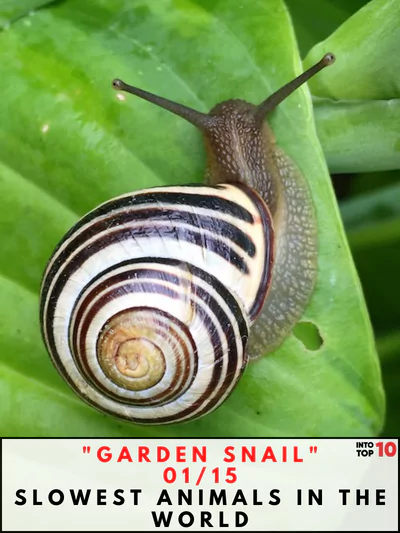
The Garden Snail, scientifically known as Helix aspersa, is a creature of remarkable simplicity and elegance. Recognizable by its coiled shell and soft, slimy body, this snail embodies slowness. These gastropods are herbivorous, dining on a menu of plants, leaves, and fruits. As they move, they leave behind a glistening trail of mucus, which serves multiple purposes. It helps maintain moisture and provides a slick surface for smoother crawling. This slime trail also acts as a communication and navigation for other snails.
The Garden Snail’s leisurely pace can be attributed to several factors. First and foremost, its soft, malleable body is not built for rapid movement. Additionally, the need to conserve energy plays a significant role. By moving slowly and steadily, they reduce energy expenditure, a crucial adaptation for survival.
This creature’s deliberate movements are about conserving energy and serving as a defense mechanism. Their slowness helps them avoid predators in a world where speed often means the difference between life and death. The word “slowest animal in the world” holds for the Garden Snail, as it embodies the essence of slowness in the animal kingdom.
03. Three-Toed Sloth – Life in the Slow Lane
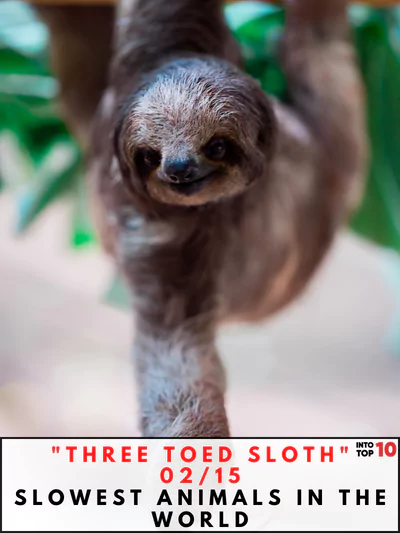
We encounter the Three-Toed Sloth from the terrestrial to the arboreal realm. These incredible creatures inhabit the rainforests of Central and South America, where they have mastered the art of unhurried living. Unlike the Garden Snail, sloths are mammals, but they are still known for their remarkable slowness.
One of their distinguishing features is their impressive camouflage, which helps them blend seamlessly into the lush green canopy. Three-toed sloths are primarily herbivores, with leaves constituting a significant portion of their diet. These leaves are not nutrient-rich, requiring a slow, energy-efficient digestive system.
The Three-Toed Sloth’s leisurely pace is primarily a result of their prolonged metabolism. Their diet of low-nutrient leaves provides little energy, so moving slowly is essential for survival. They conserve energy by sleeping up to 15 hours daily, hanging upside down from tree branches.
In the quest for food, they climb down from their tree homes once a week, a journey that can take hours. Their slow movements are a trade-off for their energy-efficient lifestyle, allowing them to thrive in the canopy while minimizing their need for fast-paced activities. This slowest animal in the world is ranked no—02 on this list.
03. Starfish – Slow and Steady

Now, let’s shift our gaze beneath the ocean’s surface to discover the stagnant world of starfish, also known as sea stars. These captivating creatures are found in oceans worldwide, and while they may not appear slow compared to land animals, their mode of locomotion is indeed unhurried.
The slowness of starfish can be attributed to their unique anatomy and decentralized nervous system. Unlike animals with centralized brains, starfish have a decentralized network of nerves called a nerve ring. This decentralized system contributes to their unhurried movements. The methodical movements and distinctive anatomy of starfish, the world’s slowest animal, make it worthy of inclusion in this list.
04. Star-Nosed Mole – A Delicate Touch
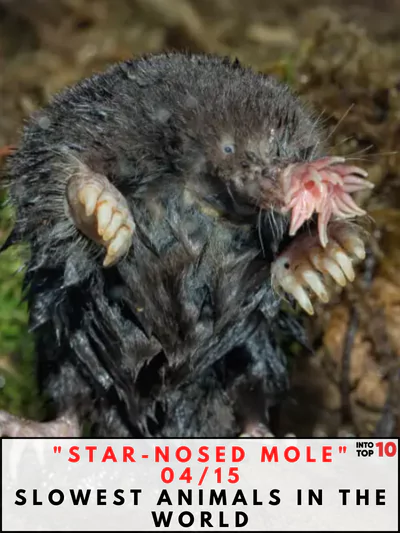
As we journey to the underground world, we encounter the Star-Nosed Mole, a fascinating creature residing in the wetlands of North America. While slower than other animals on our list, it’s known for its deliberate pace when navigating underground tunnels.
The Star-Nosed Mole’s leisurely pace can be partially attributed to its underground habitat. Tight tunnels and confined spaces don’t allow for rapid motion. Instead, it relies on its sensitive nose to find prey efficiently in low-light conditions.
While it may not be the slowest animal overall, the Star-Nosed Mole’s deliberate movements in its specific habitat are worth noting in the context of slowness in the animal kingdom.
05. Dugong – Graceful Swimmer, Slow Mover

Our next entry, the Dugong, often called the “sea cow,” is a marine mammal known for its graceful underwater behavior. Although they are excellent swimmers, their movements on land or when grazing underwater are notably slow. Dugongs are primarily herbivores, with seagrass making up the bulk of their diet.
Moreover, this slowest animal is adapted for an inactive lifestyle in the water, where they find their primary food source, seagrass. Their sluggish grazing behavior allows them to efficiently forage without expending excess energy. Unlike some marine mammals that rely on speed to catch prey, Dugongs are content with a more leisurely approach.
06. Sea Anemone – Life in the Slow Current

Sea Anemones, while not commonly associated with slowness, possess unique qualities that merit their inclusion. These marine animals are relatives of corals and jellyfish and are often found attached to rocks or other substrates on the ocean floor.
The slowness of Sea Anemones is primarily due to their sessile (stationary) lifestyle. Once they attach themselves to a suitable surface, they remain in place for most of their lives. Their passive nature allows them to conserve energy and focus on capturing prey that comes within reach.
07. Banana Slug – The Cautious Crawler

The Banana Slug, with its vibrant yellow coloration and mucus-covered body, is a distinctive inhabitant of the Pacific Northwest of North America. These mollusks may not win any races, but they have a unique charm.
Banana Slugs are hermaphrodites, possessing both male and female reproductive organs. They navigate their surroundings leisurely, often leaving behind a slime trail, similar to Garden Snails. Their primary diet includes decaying plant material and fungi.
Banana Slugs’ slowness can be attributed to their soft, gelatinous bodies and the need to conserve energy. They are susceptible to desiccation, and their slime trail is a crucial moisture-retaining mechanism.
08. American Woodcock – A Deliberate Dance

The American Woodcock, a bird native to eastern North America, is known for its distinctive courtship display, often called the “timberdoodle dance.” While their courtship dance is quite energetic, their movements are slow and deliberate.
Woodcocks are ground-dwelling birds with plump bodies, long bills, and mottled brown plumage. They use their long bills to probe the soil for earthworms and other invertebrates, their primary food source.
The American Woodcock’s slow pace can be attributed to its hunting strategy. By moving slowly and methodically through the forest floor, they are more likely to detect the vibrations of earthworms moving beneath the surface. This specialized feeding behavior requires patience and precision.
While not the slowest animal in the world, the American Woodcock’s unique combination of slow ground movements and energetic courtship displays make it a noteworthy addition to our list.
09. Gila Monster – Lethargic Lizard
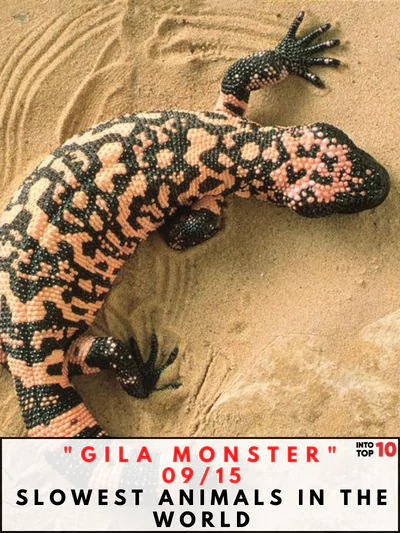
The Gila Monster, a venomous lizard found in the southwestern United States and northwestern Mexico, may not win any sprinting competitions. These lizards are characterized by their distinctive black and pinkish-orange coloration.
The Gila Monster’s lethargy is partially a result of its energy conservation strategy. By moving slowly and conserving energy, they are better equipped to survive in arid desert environments where food can be scarce.
Their sluggishness is also tied to their hunting style. Instead of actively pursuing prey, they rely on patience and stealth, waiting for an opportunity to strike.
10. Giant Galapagos Tortoise – The Majestic Plodder
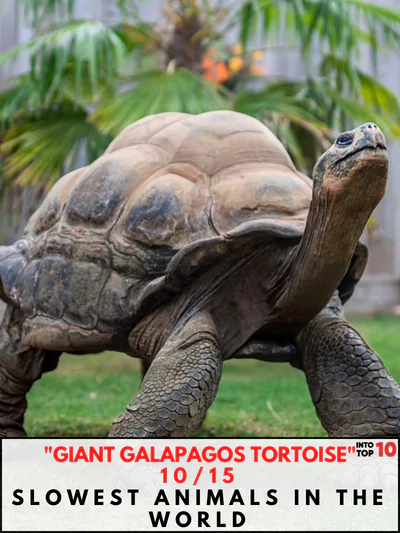
The Galapagos Islands are home to the majestic Giant Galapagos Tortoise, known for its colossal size and ponderous pace. These tortoises are among the most giant land tortoises in the world, with some individuals exceeding 4 feet in length.
Their slow and deliberate movements starkly contrast to their size, and they primarily feed on vegetation found on the islands. Despite their slow pace, they are known for their longevity, with some individuals living well over a century.
The Giant Galapagos Tortoise’s slowness can be attributed to its massive size and energy conservation strategy. Their size necessitates a slow pace, and their long necks allow them to reach vegetation without requiring rapid movement.
These tortoises have evolved to thrive in the unique ecosystems of the Galapagos Islands, where food is often abundant and competition is minimal. Their slow pace is a testament to their successful adaptation to their environment.
11. Dwarf Seahorse – A Tiny Drifter

The Dwarf Seahorse is one of the smallest seahorse species, measuring just a few centimeters in length. These seahorses are found in coastal waters worldwide and have unique adaptations for a slow-paced life.
Dwarf Seahorses are well-camouflaged, often blending seamlessly with the coral and seagrass they inhabit. They are not active swimmers but prefer to anchor themselves to a stationary object and sway gently with the current, drifting along with the ebb and flow of the tide.
The Dwarf Seahorse’s diminutive size and lack of rapid swimming abilities contribute to its slowness. However, their ability to anchor themselves and drift with the current is a strategic adaptation that conserves energy while allowing them to remain hidden from predators.
These seahorses are a remarkable example of how creatures of all sizes have found unique ways to thrive in their respective environments while embracing a slow and steady approach to life.
12. Manatees – Gentle Giants of the Water

Returning to the water, we encounter the gentle giants of the sea, the Manatees. These large, slow-moving mammals inhabit the coastal waters of the Americas and are known for their peaceful demeanor. Manatees have heavy bodies and paddle-like flippers, which they use for slow, graceful swimming. They are herbivorous, primarily feeding on aquatic plants such as seagrass.
Manatees’ slowness can be attributed to their large, heavy bodies and a diet that requires them to graze extensively on seagrass beds. Their slow movements are a trade-off for their herbivorous lifestyle, which provides them with the necessary sustenance.
Despite their leisurely pace, Manatees have successfully adapted to their aquatic habitats, showcasing the beauty of slow, graceful movements beneath the water’s surface.
13. Koala – Laid-Back Leaf Eater
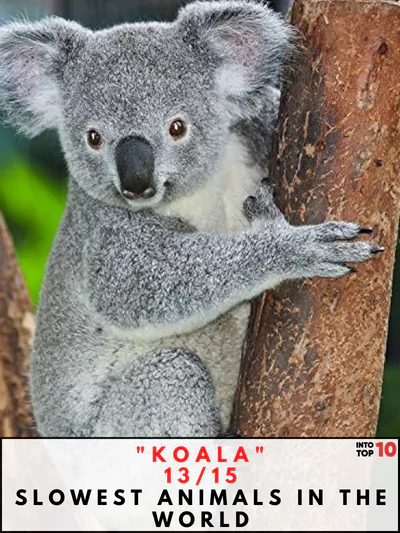
The Koala, native to Australia, is often associated with a laid-back lifestyle. These marsupials are arboreal creatures that spend most of their time perched in eucalyptus trees, feeding on eucalyptus leaves.
Koalas have a distinctive appearance with round faces and large, fluffy ears. While they are skilled climbers, their movements on land are slow and deliberate.
The Koala’s leisurely pace is primarily due to its diet of eucalyptus leaves, which are low in nutrients and high in toxins. Digesting these leaves is time-consuming, requiring the Koala to conserve energy in other aspects of its life, including movement.
Koalas’ slow and deliberate climbing and ground movements contrast with their agility in the trees, where they effortlessly navigate the branches.
14. Slow Loris – The Cautious Primate

The Slow Loris, found in Southeast Asia, is a small, nocturnal primate known for its deliberate movements. These primates have large eyes and a nasty bite, making them a unique and enigmatic species.
Slow Lorises primarily feed on insects, tree sap, and nectar. They move slowly through the trees at night, using their precise and cautious movements to locate prey. Its slowness is tied to its nocturnal lifestyle and hunting strategy. Moving slowly and deliberately allows them to find insects and other games precisely in the dark of night.
Their venomous bite is another adaptation that helps them capture prey. Their slow approach to hunting ensures they don’t catch up, even in the dimly lit forest canopy.
15. Greenland Shark – The Ocean’s Mystery

Our journey through the slowest animals in the world concludes with the enigmatic Greenland Shark. These massive sharks inhabit the cold waters of the North Atlantic and Arctic Oceans and are known for their slow, leisurely pace.
Greenland Sharks are among the largest species of shark, with some individuals reaching lengths of up to 24 feet or more. They primarily feed on fish and scavenged carrion and are believed to have exceptionally long lifespans, possibly exceeding 400 years.
The Greenland Shark’s slowness is primarily attributed to its cold-water habitat and low metabolism. Cold temperatures slow down metabolic processes, resulting in reduced activity levels. Their diet of fish and carrion also allows them to adopt a more sedentary lifestyle, relying on scavenging rather than active hunting.
These sharks have long puzzled scientists with their slow growth rates and extended lifespans, making them one of the ocean’s most intriguing mysteries.
Conclusion:
In a world where speed often takes center stage, these 15 slowest animals offer a different perspective on the art of survival. From the Garden Snail’s deliberate crawl to the Greenland Shark’s mysterious glide, each creature has remarkably adapted to its environment.
As we delve into the world of these slow-moving marvels, we discover that slowness is not a limitation but a survival strategy. Whether conserving energy, camouflaging in their surroundings, or patiently waiting for opportunities, these animals have perfected the art of taking life at their own pace.
So, the next time you encounter a slow-moving creature in the wild or your garden, take a moment to appreciate the beauty of their unhurried existence. In a world that often rushes by, these animals remind us that sometimes, the slow lane offers its unique wonders and wisdom.
















